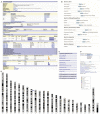Human transporter database: comprehensive knowledge and discovery tools in the human transporter genes
- PMID: 24558441
- PMCID: PMC3928311
- DOI: 10.1371/journal.pone.0088883
Human transporter database: comprehensive knowledge and discovery tools in the human transporter genes
Erratum in
- PLoS One. 2014;9(5):e98396
Abstract
Transporters are essential in homeostatic exchange of endogenous and exogenous substances at the systematic, organic, cellular, and subcellular levels. Gene mutations of transporters are often related to pharmacogenetics traits. Recent developments in high throughput technologies on genomics, transcriptomics and proteomics allow in depth studies of transporter genes in normal cellular processes and diverse disease conditions. The flood of high throughput data have resulted in urgent need for an updated knowledgebase with curated, organized, and annotated human transporters in an easily accessible way. Using a pipeline with the combination of automated keywords query, sequence similarity search and manual curation on transporters, we collected 1,555 human non-redundant transporter genes to develop the Human Transporter Database (HTD) (http://htd.cbi.pku.edu.cn). Based on the extensive annotations, global properties of the transporter genes were illustrated, such as expression patterns and polymorphisms in relationships with their ligands. We noted that the human transporters were enriched in many fundamental biological processes such as oxidative phosphorylation and cardiac muscle contraction, and significantly associated with Mendelian and complex diseases such as epilepsy and sudden infant death syndrome. Overall, HTD provides a well-organized interface to facilitate research communities to search detailed molecular and genetic information of transporters for development of personalized medicine.
Conflict of interest statement
Figures


Similar articles
-
KOBAS 2.0: a web server for annotation and identification of enriched pathways and diseases.Nucleic Acids Res. 2011 Jul;39(Web Server issue):W316-22. doi: 10.1093/nar/gkr483. Nucleic Acids Res. 2011. PMID: 21715386 Free PMC article.
-
Medicago truncatula transporter database: a comprehensive database resource for M. truncatula transporters.BMC Genomics. 2012 Feb 6;13:60. doi: 10.1186/1471-2164-13-60. BMC Genomics. 2012. PMID: 22309450 Free PMC article.
-
Feature, Function, and Information of Drug Transporter-Related Databases.Drug Metab Dispos. 2022 Jan;50(1):76-85. doi: 10.1124/dmd.121.000419. Epub 2021 Aug 23. Drug Metab Dispos. 2022. PMID: 34426411 Review.
-
TSdb: a database of transporter substrates linking metabolic pathways and transporter systems on a genome scale via their shared substrates.Sci China Life Sci. 2011 Jan;54(1):60-4. doi: 10.1007/s11427-010-4125-y. Epub 2011 Jan 21. Sci China Life Sci. 2011. PMID: 21253872
-
e-PKGene: a knowledge-based research tool for analysing the impact of genetics on drug exposure.Hum Genomics. 2011 Jul;5(5):506-15. doi: 10.1186/1479-7364-5-5-506. Hum Genomics. 2011. PMID: 21807605 Free PMC article. Review.
Cited by
-
Exploration of Target Spaces in the Human Genome for Protein and Peptide Drugs.Genomics Proteomics Bioinformatics. 2022 Aug;20(4):780-794. doi: 10.1016/j.gpb.2021.10.007. Epub 2022 Mar 23. Genomics Proteomics Bioinformatics. 2022. PMID: 35338014 Free PMC article.
-
Low Basal CB2R in Dopamine Neurons and Microglia Influences Cannabinoid Tetrad Effects.Int J Mol Sci. 2020 Dec 21;21(24):9763. doi: 10.3390/ijms21249763. Int J Mol Sci. 2020. PMID: 33371336 Free PMC article.
-
TransportDB 2.0: a database for exploring membrane transporters in sequenced genomes from all domains of life.Nucleic Acids Res. 2017 Jan 4;45(D1):D320-D324. doi: 10.1093/nar/gkw1068. Epub 2016 Nov 28. Nucleic Acids Res. 2017. PMID: 27899676 Free PMC article.
-
Metabolic mapping of the human solute carrier superfamily.Mol Syst Biol. 2025 Jun;21(6):560-598. doi: 10.1038/s44320-025-00106-4. Epub 2025 May 12. Mol Syst Biol. 2025. PMID: 40355754 Free PMC article.
-
Multi-tissue transcriptomics for construction of a comprehensive gene resource for the terrestrial snail Theba pisana.Sci Rep. 2016 Feb 8;6:20685. doi: 10.1038/srep20685. Sci Rep. 2016. PMID: 26852673 Free PMC article.
References
-
- Nelson DL, Lehninger AL, Cox MM (2008) Lehninger principles of biochemistry. New York: W.H. Freeman.
-
- Overington JP, Al-Lazikani B, Hopkins AL (2006) How many drug targets are there? Nat Rev Drug Discov 5: 993–996. - PubMed
-
- Rask-Andersen M, Almen MS, Schioth HB (2011) Trends in the exploitation of novel drug targets. Nat Rev Drug Discov 10: 579–590. - PubMed
-
- Ware JA (2006) Membrane transporters in drug discovery and development: A new mechanistic ADME era. Mol Pharm 3: 1–2. - PubMed
Publication types
MeSH terms
Substances
Grants and funding
LinkOut - more resources
Full Text Sources
Other Literature Sources

